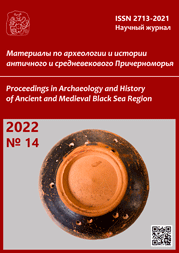Надмогильная стела XV в. из селения Ашты — высокохудожественное произведение исламского искусства Горного Дагестана
The 15th century grave stele from the village of Ashty — a highly masterful work of Islamic art in Mountain Dagestan
Author(s): M.M. MammaevSubject(s): Archaeology, Fine Arts / Performing Arts, Islam studies
Published by: Нижневартовский государственный университет
Keywords: Dagestan; Kubachi; Ashty; Islamic art; stone carving; grave stele; Arabic epigraphy;
Summary/Abstract: The grave stele of the 15th century from the village of Ashty (Dakhadaev district, Republic of Dagestan) is a massive subtrapezoidal stone slab. It is decorated with rich floral ornament in artistically skilful manner. The relief round medallion in the center of the upper part of the monument is encircled with engraved epitaph in Arabic, which contains the buried person’s name (Ali son of Ahmad) and dates of his death and, consequently, of the manufacture of the monument: Jumada al-Akhira 877 AH (November 11 — December 10, 1472). In the centre of the medallion a calligraphic relief inscription “Allah” is made. In a small round medallion situated in the middle part of the central field, another relief inscription is placed, with the name of Muhammad, the Prophet and Allah’s Messenger. It is peculiarities of decorative design, perfectly bright and expressive ornamental carving, and the presence of Arabic inscriptions, which attest the Ashty stele as a highly valuable masterpiece of stone-carving art, Arabic epigraphy, and calligraphy. The stele is explored in terms of comparison with the monuments of the same time range from Kubachi, Datsamazhe and Kumukh. The ornamentation of the Ashty stele is found to have closest parallels in carved Muslim stelae from the village of Kubachi as well as in those from the settlement of Datsamazhe. In the 15th century, Ghazi-Kumukh Shamkhalate dominated Ashty, yet the villagers have managed to retain traditional economic and cultural connections with ethnically related Kubachi people.
Journal: Материалы по археологии и истории античного и средневекового Причерноморья
- Issue Year: 2022
- Issue No: 14
- Page Range: 421-431
- Page Count: 11
- Language: Russian

